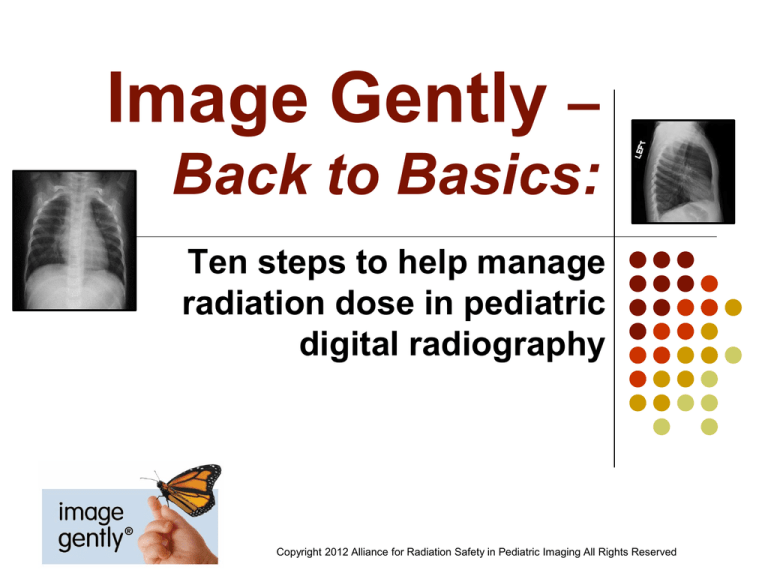
Image Gently –
Back to Basics:
Ten steps to help manage
radiation dose in pediatric
digital radiography
Copyright 2012 Alliance for Radiation Safety in Pediatric Imaging All Rights Reserved
The Alliance for
Radiation Safety in
Pediatric Imaging
The image gently campaign
What is Image Gently
An education, awareness and advocacy campaign
To improve radiation protection for children worldwide
Alliance for Radiation Safety in Pediatric Imaging
>70 health care organizations/agencies
>800,000 radiologists
radiology technologists
medical physicists worldwide
Copyright 2012 Alliance for Radiation Safety in Pediatric Imaging All Rights Reserved
The Alliance for Radiation
Safety in Pediatric Imaging
The Image Gently Alliance
is a coalition of health care organizations dedicated to
providing safe, high quality pediatric imaging worldwide.
The primary objective of the Alliance is to raise
awareness in the imaging community of the need to
adjust radiation dose when imaging children.
The ultimate goal of the Alliance is to change practice.
Copyright 2012 Alliance for Radiation Safety in Pediatric Imaging All Rights Reserved
Objectives
Raise awareness of opportunities to lower radiation
dose while maintaining diagnostic image quality
when imaging children
Address methods to standardize the approach to
pediatric digital radiography
Highlight challenges related to the technology when
used with patients of widely variable body size
Copyright 2012 Alliance for Radiation Safety in Pediatric Imaging All Rights Reserved
Imaging Statistics
Radiography is the most common type of
exam in diagnostic imaging
74% of all imaging exams
Represents 85% of all ionizing radiation studies in
children
During a three-year radiography study:
40% children had 1 study
22% had 2
14% had >3
Copyright 2012 Alliance for Radiation Safety in Pediatric Imaging All Rights Reserved
Changing of Technology
Digital radiography has largely replaced
screen-film (SF) radiography throughout the
United States
Imaging community is responsible for
understanding technology changes
Exposure creep – increase in technique
factors over time
Copyright 2012 Alliance for Radiation Safety in Pediatric Imaging All Rights Reserved
Exposure Creep
Image processing compensates for
underexposure and overexposure
Radiologists prefer noise-free images
Overexposure common
40% of adult digital radiographs overexposed
43% of pediatric digital radiographs overexposed
Step 1. Understand the basics
of digital radiography
Digital radiography encompasses both computed
radiography (CR) and direct digital radiography (DR)
Computed Radiography (CR)
Readout
process
• Separate laser reader from the
image receptor
• Readout availability in 30-40
seconds
Image
Receptors
• Photostimulable-phosphor plate
• Needle phosphor plate (CsBr)
Copyright 2012 Alliance for Radiation Safety in Pediatric Imaging All Rights Reserved
Step 1. Understand the basics
of digital radiography
Direct Digital Radiography (DR)
Readout
process
• Thin-film transistor layer bonded with image
receptor
• Readout availability in less than 10 seconds
Two types depending on method of converting xImage
Receptors ray to image
1. Direct converts x-rays to electrical charge
• Selenium most common type of receptor
2. Indirect converts x-rays to light which then
produces electrical charge
• CsI and Gadolinium Oxysulfide most
common types
Copyright 2012 Alliance for Radiation Safety in Pediatric Imaging All Rights Reserved
Step 1. Understand the basics
of digital radiography
Digital radiography advantages over
traditional SF radiography
Latitude of exposure ~ 100 times greater
Image manipulation (processing)
Electronic images can be stored and distributed
anywhere
Point-of-care image access
Copyright 2012 Alliance for Radiation Safety in Pediatric Imaging All Rights Reserved
Step 1. Understand the basics
of digital radiography
Digital radiography performance
Characterized by spatial resolution and noise
Sharpness/Modulation Transfer Function (MTF)
Noise Level/Noise Power Spectrum (NPS)
Characteristics determine efficiency of the system
in converting x-rays into an image
Described as Detective Quantum Efficiency (DQE)
Copyright 2012 Alliance for Radiation Safety in Pediatric Imaging All Rights Reserved
Step 1. Understand the basics
of digital radiography
Detective Quantum Efficiency (DQE)
Function of spatial frequency
Ideal detector has a DQE of 1.0
For lower beam energies used in pediatric radiology,
experiments show that DR with CsI can achieve
higher DQE than CR and SF radiography
The higher the DQE, less radiation exposure is
needed to achieve the same image quality
Copyright 2012 Alliance for Radiation Safety in Pediatric Imaging All Rights Reserved
Step 1. Understand the basics
of digital radiography
Radiologists, technologists, and medical
physicists must leverage the strengths and
weaknesses of each of their detectors to optimize
exposure factors and reduce doses, especially
when imaging children
Copyright 2012 Alliance for Radiation Safety in Pediatric Imaging All Rights Reserved
Step 2. Understand challenges
associated with digital imaging
Screen-film radiography provided
immediate and direct feedback regarding
overexposure or underexposure
Overexposed image was too black
Underexposed image was too white
Optical density was directly coupled to the
exposure technique
Copyright 2012 Alliance for Radiation Safety in Pediatric Imaging All Rights Reserved
Step 2. Understand challenges
associated with digital imaging
Digital radiography is fundamentally different
Optical density feedback is lost
Image processing adjusts grayscale images to
the correct brightness despite underexposure
or overexposure
Copyright 2012 Alliance for Radiation Safety in Pediatric Imaging All Rights Reserved
Step 2. Understand challenges
associated with digital imaging
Underexposed digital images
Fewer x-rays absorbed by the detector
Results in increased quantum mottle
The image appears noisy or grainy
Increased exposure in digital imaging
Reduction in quantum mottle
Overexposure may go unnoticed
Results in needless overexposure and
potential harm to the patient
Copyright 2012 Alliance for Radiation Safety in Pediatric Imaging All Rights Reserved
Step 2. Understand challenges
associated with digital imaging
Image acquisition process varies
Depends on vendor and equipment type
Techniques may be different than SF
Requires technologists to adjust techniques
Different detectors may require different
techniques due to differences in efficiency
(DQE)
Copyright 2012 Alliance for Radiation Safety in Pediatric Imaging All Rights Reserved
Step 2. Understand challenges
associated with digital imaging
Need for a standard approach
Differences in technique amongst digital systems
may cause confusion
Result in varying levels of image quality
Approach must be based on:
1. Feedback provided from exposure indicator
2. Individual image quality analysis
Copyright 2012 Alliance for Radiation Safety in Pediatric Imaging All Rights Reserved
Step 3. Learn new exposure
terminology standards
Proprietary Exposure Indicator Terminology
Method for estimating exposure to image receptor
May be linear or logarithmic
Directly or inversely related to plate exposure
Hospitals frequently have more than one
detector type from more than one vendor
Difficult to familiarize with all of the proprietary
exposure terminology
Causes confusion
Step 3. Learn new exposure
terminology standards
Solution to the exposure terminology problem
2004 ALARA conference in digital radiography
AAPM and IEC
Developed standardized terminology designed to
eliminate proprietary terminology in the installed
equipment in the future
Medical Imaging and Technology Alliance (MITA)
Publically agreed to adopt the IEC standard
Copyright 2012 Alliance for Radiation Safety in Pediatric Imaging All Rights Reserved
Step 3. Learn new exposure
terminology standards
IEC standard terms to learn:
Target exposure index (EIT)
Exposure index (EI)
Deviation index (DI)
Copyright 2012 Alliance for Radiation Safety in Pediatric Imaging All Rights Reserved
Step 3. Learn new exposure
terminology standards
Target exposure index (EIT)
Ideal exposure at the image receptor
Can be set by:
Manufacturer
User
facility
Copyright 2012 Alliance for Radiation Safety in Pediatric Imaging All Rights Reserved
Step 3. Learn new exposure
terminology standards
Exposure index (EI)
Image receptor radiation exposure
Value depends on:
Measured in relevant region
Direct, linear with respect to mAs
Doubling the mAs will double the EI
Body part selected and body part thickness,
kVp and any added filtration
Type of detector
EI it is NOT an individual patient dose metric
Copyright 2012 Alliance for Radiation Safety in Pediatric Imaging All Rights Reserved
Step 3. Learn new exposure
terminology standards
Deviation index (DI)
Indicates how much the EI deviates from the
EIT
The DI is defined as:
DI= 10×log10 (EI/EIT)
Copyright 2012 Alliance for Radiation Safety in Pediatric Imaging All Rights Reserved
Step 3. Learn new exposure
terminology standards
The meaning of DI
An ideal situation where EI is equal to the EIT,
the DI is zero (DI =0)
If the exposure index is higher than the EIT
(overexposed), the DI is positive, and if it is lower
than the EIT (underexposed), the DI is negative
A DI of -1 is 20% below the appropriate exposure,
while +1 is a 26% overexposure
A DI of ±3 indicates halving or doubling of the
exposure relative to the EIT
Copyright 2012 Alliance for Radiation Safety in Pediatric Imaging All Rights Reserved
Step 3. Learn new exposure
terminology standards
Deviation
Index
Percentage
(%)
-3.0
-1.0
0
+1
+3
50
80
100
126
200
Underexposure
{
Ideal
Overexposure
{
Step 3. Learn new exposure
terminology standards
The importance of DI
Immediate feedback
Indicates the adequacy of the exposure
Goal -1 < DI > +1
Few studies DI > +3 or <-3
Standardized terminology will reduce confusion
from proprietary terminology
Copyright 2012 Alliance for Radiation Safety in Pediatric Imaging All Rights Reserved
Step 3. Learn new exposure
terminology standards
Deviation Index is only one factor in image
quality:
To assure image quality, checks should be
made for : positioning, patient motion,
collimation, and appropriate use of grids
Image noise levels for underexposure and saturation with
overexposure should also be monitored
The Image Gently Campaign encourages
radiologists and technologists to go “Back to
BASICS” with digital radiography
Copyright 2012 Alliance for Radiation Safety in Pediatric Imaging All Rights Reserved
Step 4. Establish technique
charts using a team approach
Automatic exposure control (AEC) sensors,
commonly used in adults, is often problematic
in children
For smaller children the imaged area of anatomy
may be smaller than the single central sensor
Goske, M. J., E. Charkot, et al.(2011). Pediatr
Radiol 41(5): 611-619. Reused with permission.
Copyright 2012 Alliance for Radiation Safety in Pediatric Imaging All Rights Reserved
Step 4. Establish technique
charts using a team approach
Manual techniques may be most appropriate
for small children
Team approach:
Physician, technologist, medical physicist, vendor
Start with limited exams:
Chest, abdomen, small parts
May need detector-specific technique charts
Copyright 2012 Alliance for Radiation Safety in Pediatric Imaging All Rights Reserved
Step 4. Establish technique
charts using a team approach
Image processing is different for pediatric
patients and adults
Review and adjust anatomically
programmed radiography techniques
Appropriate values must be included for both AEC and
manual technique selection
Pre-programmed adult techniques used for
pediatric imaging may not result in the
appropriate image quality or patient dose
Copyright 2012 Alliance for Radiation Safety in Pediatric Imaging All Rights Reserved
Step 5. Measure body part
thickness
X-ray absorption/transmission depends on the
composition of the body part being imaged
Body part thickness is the most important
technique determinant
One cannot reliably use patient age as a guide
for techniques
The largest 3-year old’s abdomen thickness
is the same as the smallest 18-year old
Copyright 2012 Alliance for Radiation Safety in Pediatric Imaging All Rights Reserved
Step 5. Measure body part
thickness
Revert “Back to Basics”
The goal is for reproducible, consistent images
for children with a body part of the same size
Use calipers to measuring patients
Ensures standardized technique is selected
One then selects kV, filtration, and mAs for that
specific study to “child size” the examination
Copyright 2012 Alliance for Radiation Safety in Pediatric Imaging All Rights Reserved
Step 6. Use grids only when
body part thickness is > 12 cm
Anti-scatter grids remove scatter from the image
Grids improve the subject contrast
Scatter degrades image when the body part is
>12 cm of water-equivalent thickness
Air containing structures greater than 12 cm
thickness can be imaged without a grid
Example: chest radiographs
Copyright 2012 Alliance for Radiation Safety in Pediatric Imaging All Rights Reserved
Step 6. Use grids only when
body part thickness is > 12 cm
Grids may double or triple the exposure factors
necessary to obtain an adequate image
Removing the grid when it is not necessary greatly
reduces patient exposure
Guidelines for digital radiography have stated that
grids should be used sparingly in pediatrics
Copyright 2012 Alliance for Radiation Safety in Pediatric Imaging All Rights Reserved
Step 7. Collimate prior to the
exposure
It is unacceptable to open the collimators, then
manipulate and electronically crop the image after
the exposure
ASRT survey: 50% of the technologists use electronic
cropping of the image after the exposure 75% of the
time
Radiologists may not be aware that cropping is
occurring, yet radiologists are responsible for the
image before cropping occurs
Copyright 2012 Alliance for Radiation Safety in Pediatric Imaging All Rights Reserved
Step 7. Collimate prior to the
exposure
The cropped portions of the body are exposed to
unnecessary radiation
It is better to properly immobilize patient and collimate
appropriately before the exposure
Copyright 2012 Alliance for Radiation Safety in Pediatric Imaging All Rights Reserved
Step 7. Collimate prior to the
exposure
Benefits of collimation:
Reduces the area exposed and lowers the dose-area
product (DAP)
Reduces scatter radiation, which will improve image
quality
Improves the accuracy of the image processing
Provides more accurate exposure indicator
Copyright 2012 Alliance for Radiation Safety in Pediatric Imaging All Rights Reserved
Step 8. Display technique
factors for each image
Require that the kVp, mAs, EI and, especially,
DI are present on the displayed image
Ideally DAP meter results and image processing
program should also be displayed
These displayed values provide important
feedback to the radiologist and technologists
Copyright 2012 Alliance for Radiation Safety in Pediatric Imaging All Rights Reserved
Image Courtesy of Ann & Robert H.
Lurie Children’s Hospital of Chicago
Step 9. Accept noise level
appropriate to clinical question
Radiologists prefer images that have little noise
However, noise intolerance can lead to exposure
creep
Must work to understand the relationship between
exposure indicators and the visual appearance of
noise in an image
Routinely monitoring the appropriateness of the
technique based on the level of image noise
along with the DI, exposure creep be avoided
Copyright 2012 Alliance for Radiation Safety in Pediatric Imaging All Rights Reserved
Step 10. Develop a quality
assurance program
It is critical that radiologists, radiographers,
and physicists develop standards for their
institution, utilizing a team approach to assure
diagnostic image quality at a properly
managed dose for pediatric patients.
Copyright 2012 Alliance for Radiation Safety in Pediatric Imaging All Rights Reserved
Step 10. Develop a quality
assurance program
Importance of QA program
40% of the digital radiographs obtained from one
adult center are overexposed
43% of radiographs in a pediatric center were
reported as overexposed
By recording and monitoring exposure indicators, an individual
hospital can control and reverse exposure creep
Copyright 2012 Alliance for Radiation Safety in Pediatric Imaging All Rights Reserved
Step 10. Develop a quality
assurance program
Analyzing the percentage of images that fall
within and outside of an acceptable range can
be used to educate technologists and
decrease the variation while improving image
quality goals of the department
Copyright 2012 Alliance for Radiation Safety in Pediatric Imaging All Rights Reserved
Step 10. Develop a quality
assurance program
Utilizing digital imaging resources
DICOM headers contain information that can
be exported and used in QA programs
IHE REM profiles make additional information
available
Common IEC standard terminology can also
be used
Copyright 2012 Alliance for Radiation Safety in Pediatric Imaging All Rights Reserved
Step 10. Develop a quality
assurance program
Likely in the future:
National diagnostic reference levels to
compare digital radiographic techniques
ACR Dose Index Registry program for
Pediatric Digital Radiography registry has
been approved
Diagnostic reference levels likely will be
developed from this data based on detector
type and body part
Copyright 2012 Alliance for Radiation Safety in Pediatric Imaging All Rights Reserved
Conclusion
Knowledge in digital radiography will provide radiologists
and technologists the basis for standardizing their
approach to imaging pediatric patients
Education will reduce the tendency for exposure creep
The “Back to Basics” Image Gently® campaign is a
reminder to standardize procedures to improve image
quality while properly managing radiation dose during
pediatric imaging
Copyright 2012 Alliance for Radiation Safety in Pediatric Imaging All Rights Reserved
References
1.Ionizing Radiation Exposure of the Population of the United States. Bethesda, MD: National Council on
Radiation Protection and Measurements, 2009
2.Dorfman AL, Fazel R, Einstein AJ, et al. Use of medical imaging procedures with ionizing radiation in
children: a population-based study. Archives of pediatrics & adolescent medicine 2011;165:458-464
3.Willis CE, Slovis TL. The ALARA concept in pediatric CR and DR: dose reduction in pediatric radiographic
exams – A white paper conference Executive Summary. Pediatric Radiology 2004;34:S162-S164
4.Korner M, Weber CH, Wirth S, Pfeifer KJ, Reiser MF, Treitl M. Advances in digital radiography: physical
principles and system overview. Radiographics 2007;27:675-686
5.Cohen M, Corea D, Wanner M, et al. Evaluation of a New Phosphor Plate Technology for Neonatal
Portable Chest Radiographs. Academic Radiology 2011;18:197-198
6.Willis C. Computed radiography: a higher dose? Pediatric Radiology 2002;32:745-750
7.Hillman BJ, Fajardo LL. Clinical assessment of phosphor-plate computed radiography: equipment,
strategy, and methods. J Dig Imag 1989;2:220-227
8.Medical electrical equipment – Characteristics of digital X-ray imaging devices – Part 1: Determination of
the detective quantum efficiency International Electrotechnical Commission (IEC), international standard IEC
62220-1, Geneva, Switzerland.2003
9.Monnin P, Gutierrez D, Bulling S, Lepori D, Valley J-F, Verdun FR. Performance comparison of an active
matrix flat panel imager, computed radiography system, and a screen-film system at four standard radiation
qualities. Medical Physics 2005;32:343-350
10.Bertolini M, Nitrosi A, Rivetti S, et al. A comparison of digital radiography systems in terms of effective
detective quantum efficiency. Medical Physics 2012;39:2617-2627
11.Seibert JA, Morin RL. The standardized exposure index for digital radiography: an opportunity for
optimization of radiation dose to the pediatric population. Pediatr Radiol 2011;41:573-581
Copyright 2012 Alliance for Radiation Safety in Pediatric Imaging All Rights Reserved
References
12.Medical electrical equipment - Exposure index of digital X-ray imaging systems - Part 1: Definitions and
requirements for general radiography International Electrotechnical Commission (IEC), international
standard IEC 62494-1, Geneva, Switzerland.2008.
13.Shepard SJ, Wang J, Flynn M, et al. An exposure indicator for digital radiography: AAPM Task Group
116 (Executive Summary). Medical Physics 2009;36:2898-2914
14.Don S, Goske MJ, John S, Whiting B, Willis CE. Image Gently pediatric digital radiography summit:
executive summary. Pediatr Radiol 2011;41:562-565
15.Vastagh S. Statement by MITA on behalf of the MITA CR-DR group of the X-ray section. Pediatr Radiol
2011;41:566
16.Don S, Whiting BR, Rutz LJ, Apgar B. New Exposure Indicators for Digital Radiography Simplified for
Radiologists and Technologists Am J Roentgenol 2012 (accepted for publication)
17.Goske MJ, Charkot E, Herrmann T, et al. Image Gently: challenges for radiologic technologists when
performing digital radiography in children. Pediatr Radiol 2011;41:611-619
18.Don S, Whiting BR, Ellinwood JS, Foos DH, Kronemer KA, Kraus RA. Neonatal chest computed
radiography: image processing and optimal image display. AJR American journal of roentgenology
2007;188:1138-1144
19.Kleinman PL, Strauss KJ, Zurakowski D, Buckley KS, Taylor GA. Patient Size Measured on CT Images
as a Function of Age at a Tertiary Care Children's Hospital. American Journal of Roentgenology
2010;194:1611-1619
20.Kalender W. Monte Carlo calculations of x-ray scatter data for diagnostic radiology. Physics in medicine
and biology 1981;26:835-849
21.Cartlon RR, Adler AM. The Grid. In: Principles of radiographic imaging : an art and a science Clifton
Park, NY: Delmar Cengage Learning, 2013
22.ACR-SPR Practice Guideline for General Radiography. American College of Radiology. Reston, VA,
2008
Copyright 2012 Alliance for Radiation Safety in Pediatric Imaging All Rights Reserved
References
23.ACR–AAPM–SIIM Practice Guidelime for Digital Radiography. American College of Radiology. Reston,
VA, 2007
24.Morrison G, John SD, Goske MJ, et al. Pediatric digital radiography education for radiologic
technologists: current state. Pediatr Radiol 2011;41:602-610
25.Curry T, Dowdey J, Murry R. In: Christensen's Physics of Diagnostic Radiology. Philadelphia: Lea &
Febiger, 1990:93-98
26.Don S. Radiosensitivity of children: potential for overexposure in CR and DR and magnitude of doses in
ordinary radiographic examinations. Pediatric Radiology 2004;34:S167-S172
27.Don S, Hildebolt CF, Sharp TL, et al. Computed radiography versus screen-film radiography: detection of
pulmonary edema in a rabbit model that simulates neonatal pulmonary infiltrates. Radiology 1999;213:455460
28.Roehrig H, Krupinski EA, Hulett R. Reduction of patient exposure in pediatric radiology. Academic
Radiology 1997;4:547-557
29.Gibson DJ, Davidson RA. Exposure Creep in Computed Radiography: A Longitudinal Study. Academic
Radiology 2012;19:458-462
30.O'Donnell K. Radiation exposure monitoring: a new IHE profile. Pediatr Radiol 2011;41:588-591
31.Cohen MD, Cooper ML, Piersall K, Apgar BK. Quality assurance: using the exposure index and the
deviation index to monitor radiation exposure for portable chest radiographs in neonates. Pediatr Radiol
2011;41:592-601
32.Cohen MD, Markowitz R, Hill J, Huda W, Babyn P, Apgar B. Quality assurance: a comparison study of
radiographic exposure for neonatal chest radiographs at 4 academic hospitals. Pediatr Radiol 2011
Copyright 2012 Alliance for Radiation Safety in Pediatric Imaging All Rights Reserved
imagegently.org
Copyright 2012 Alliance for Radiation Safety in Pediatric Imaging All Rights Reserved
Thanks to Digital Radiography
Committee Members:
Steven Don, M.D.
Robert MacDougall, MSc
Keith Strauss, MSc, FAAPM, FACR
Quentin Moore, MPH, R.T.(R)(T)(QM)
Marilyn J. Goske, M.D., FAAP
Mervyn Cohen, M.D., MBChB
Tracy Herrmann, MEd, R.T.(R)
Susan D. John, M.D
Lauren Noble, Ed.D., R.T.(R)
Greg Morrison, MA, R.T.(R), CNMT, CAE
Lois Lehman, R.T.(R)(CT)
Coreen Bell
Ceela McElveny
Loren Stacks
Shawn Farley
Copyright 2012 Alliance for Radiation Safety in Pediatric Imaging All Rights Reserved









